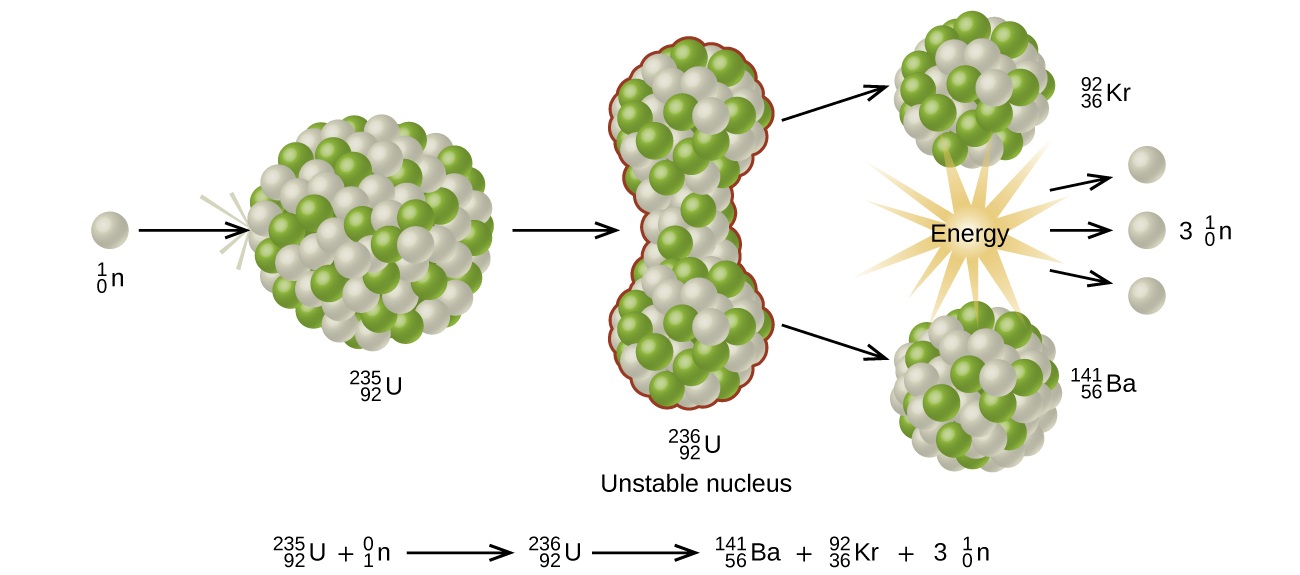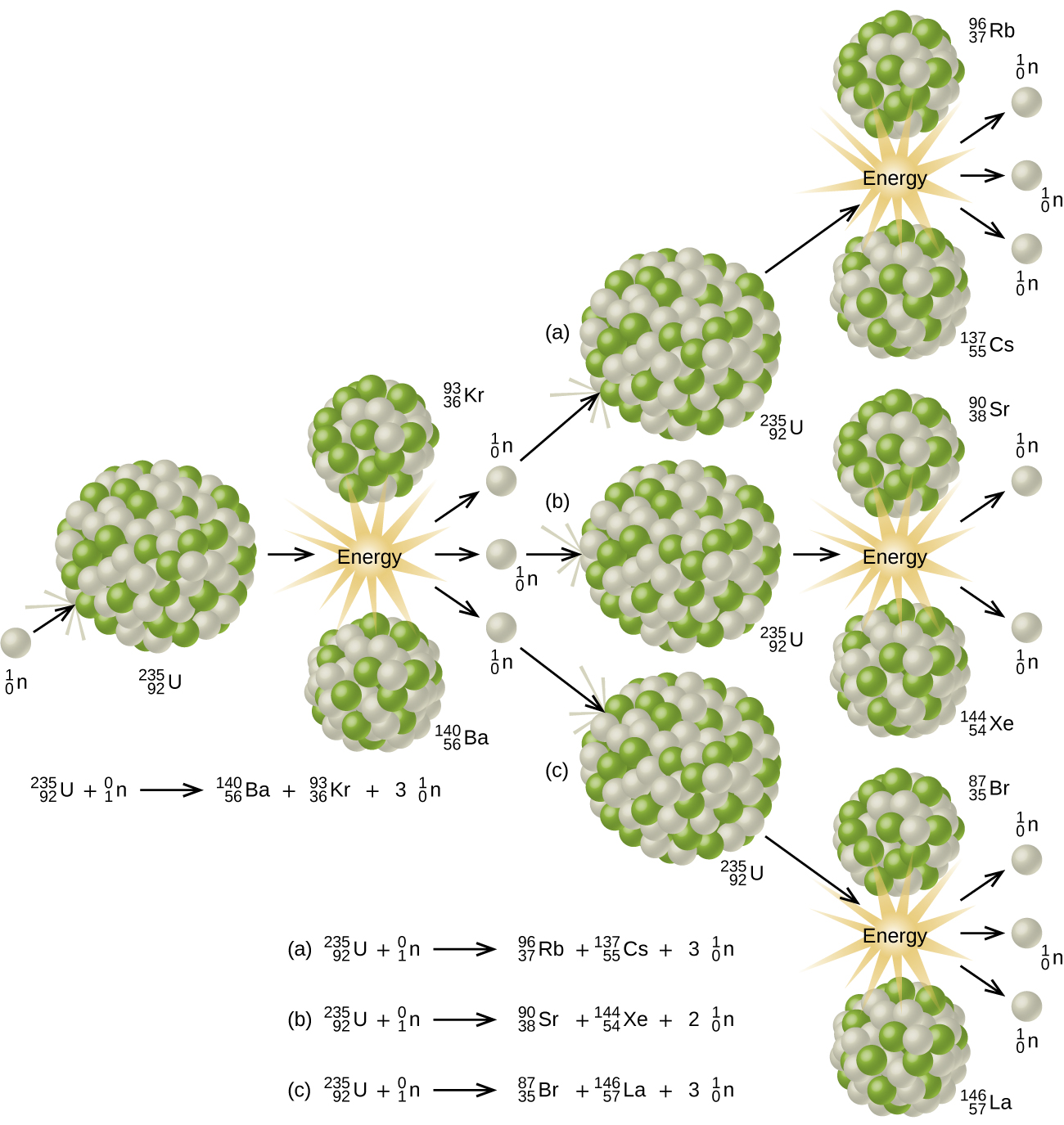Photo:

Description
Students will build on previous lessons about radiation and the forces that exist within an atom to learn the fundamental processes inside of nuclear reactors. What type of energy do nuclear reactors harness? What is the difference between a nuclear reactor and a nuclear bomb?
This lesson will answer such questions with an in-depth explanation of nuclear fission and the chain reaction, both of which are essential to the operation of any nuclear power plant.
Why it Matters
This unit describes how nuclear power, specifically fission, works. As of 2023, nuclear energy accounts for about 20% of the electricity generated in the United States. Learning how fission works is important context for the energy contributions that nuclear power plants make, both domestically and internationally. Additionally, it is especially relevant to understand fission as a foundation for contrasting nuclear power and nuclear weapons, dispelling misinformation and misconceptions about either.
Background Information
Throughout nature, there are many different types of isotopes for each element. Many are unstable and give off radiation, while many others are stable. Only a select few, though, can go through a process called fission. This refers to a nucleus splitting into separate, distinct nuclei. This is different from radioactive decay, since fission releases much more than just a gamma-ray, alpha particle, or beta particle. The image below is an illustration of the fission reaction:

A nucleus like Uranium-235 is close enough to instability that absorbing a neutron will cause it to split apart. Upon going through the fission reaction, the original Uranium nucleus will split into two distinct nuclei, along with other products. The example reaction here results in the two fission products, Barium-141 and Krypton-92. Three neutrons also come out of this fission, as well as a vast amount of energy.
But what do we mean by energy? At the atomic scale, energy (specifically kinetic energy) usually refers to the movement of particles, or how fast they're going. For example, a neutron with high kinetic energy will be moving faster than a neutron with lower kinetic energy. Since energy is a product of fission, each of the fission products and neutrons will come out of the reaction with a certain velocity according to how much kinetic energy they have. Another form of energy released during fission comes in the form of gamma rays. These rays are photons, which are 'packets' of light, or pure energy. If we add up all the energy of the products, both kinetic energy and light energy, we end up with an amount of energy that is millions of times greater than the chemical reactions found in fossil fuels.
Where does the resulting energy come from? The nucleus has the Strong Nuclear Force, and similar to chemical reactions, it has a binding energy. This binding energy is stored as mass in the nucleus. If we ask Einstein for his famous formula, E=mc2, we can see that mass and energy can be related to one another using the speed of light. If we were to add up the masses of individual neutrons and protons, their combined mass would be less than if we measured the mass of the full Uranium-235 nucleus itself. Why? The 'extra' mass of the Uranium-235 is the binding energy, which is released in the fission reaction.
When a Uranium-235 nucleus undergoes fission, it's usually started by the absorption of a neutron. While neutrons do come out of fission as some of the products, they have too much energy and are too fast to cause another fission in Uranium-235. This graph shows the fission cross section of the Uranium-235 nucleus, or roughly speaking, the likelihood of a neutron causing Uranium-235 to fission:
Here, the x-axis is the neutron energy, or how fast the neutron is going. The y-axis is the cross section. Neutrons are born (or released, as in right after fission) in the fast energy range, and are way less likely than thermal, or lower-energy neutrons, to cause fission. To keep fission reactions happening, then, a nuclear reactor needs to be able to slow these neutrons down using a moderator Materials like water and graphite are common moderators. The moderator has atoms with a nucleus that is able to absorb most of the energy from the neutrons. Just like a ball becomes slower after hitting another similarly sized ball, neutrons bounce around in the moderator, eventually slowing down for a higher chance to cause fission.
Once the neutrons are slow enough to cause other fissions, we are able to talk about the chain reaction, illustrated here:

When each fission only needs one neutron and produces even more, a chain reaction will occur, causing a large number of fissions to occur and vast amounts of energy to be released. Nuclear reactors are able to control this chain reaction by maintaining a balance of the amount of moderator and fuel and by using absorbers to keep the number of neutrons manageable, and by designing the reactor with a geometry which will also prevent too many fissions from happening. This is different from a nuclear bomb, which is designed to unleash the chain reaction as quickly as possible by keeping all of its fissioning material in one compact shape. Nuclear reactors avoid this by spreading out the fuel over a large volume and using the previously mentioned strategies. This means that a nuclear reactor is fundamentally different from a nuclear bomb, and it is physically impossible for the reactor to have a 'nuclear explosion' in the same way as a nuclear bomb.
Prerequisite Knowledge:
- Protons and neutrons make up the nucleus of an atom, all held together by the Strong Nuclear Force.
- Isotopes are atomic nuclei that have the same number of protons (and are thus the same element) but can have a different number of neutrons.
- When the Strong Nuclear Force is not enough to hold the protons and neutrons together, the nucleus can fall apart in several different ways.
Learning Objectives
- Fission happens when the right kind of nucleus absorbs a neutron, making the nucleus unstable and causing it to split.
- What comes out of a fission reaction:
- Two smaller nuclei, also called fission products.
- Several high energy neutrons, also called fast neutrons.
- Energy in each of the products.
- Atoms are more likely to absorb slower neutrons than fast neutrons. These slow neutrons can are commonly known as thermal neutrons.
- Once several fissions happen close to each other and the number of neutrons is increasing, the chain reaction has begun!
- Nuclear reactors are designed and run to control the chain reaction.
- Nuclear weapons are designed to create the fastest chain reaction possible.
Materials
- 2 table tennis (or ping pong) balls
- 1 large balloon
- 3 straight pins with spherical heads (or similarly sized Buckyballs)
- Leave one intact and remove the heads from the other two.
- A set of dominos
Material Preparation
- Insert the two ping pong balls and Buckyballs into the balloon and inflate the balloon.
- The ping pong balls will represent the fission products, the Buckyballs will represent the neutrons, and the balloon will serve as the rest of the nucleus.
- Set up the dominoes either before or after the lesson to demonstrate the chain reaction with the 'domino effect' - where knocking one down can knock down all the others.
Lab Instructions
- Upon finishing the presentation for the lab, every student should receive one set of each of the described materials. If there aren't enough materials, a single demonstration works too.
- Stuff the table tennis balls and the Buckyballs into the ballon, blow it up, and tie it. Leave the intact pin to the side.
- Each blown up balloon represents a nucleus that can undergo fission. The intact pin will represent an incoming neutron.
- If you leave the balloon on a surface, you can test out how different neutron 'energies,' or velocities, work out - try seeing how easy it is to pop the balloon by throwing the needle to it from a distance, as opposed to simply popping it up close.
- When the 'neutron' pops the balloon, several things will come out. A guessing game is a good way to review the material! What came out of the balloon, and how does it relate to what you just learned?
- The easy parts will be the ping pong balls (fission products) and the Buckyballs (neutrons). Slightly harder will be the energy that comes out of the balloon. In this case, the popping sound will represent the gammas that can come out of fission. The ping pong balls and Buckyballs also come out of the balloon moving, each with its own velocity, representing energy.
- Now, use the dominoes to represent the chain reaction. You want to try to knock enough dominos down in succession, like the domino effect. Try different amounts and arrangements! You won't have enough get knocked over if you have too few dominoes or if you have them set up too far apart from one another. Even though they may all fall down very quickly, this domino effect, or 'runaway' reaction, is what we avoid in nuclear reactors. We don't want all the energy to be released in one go. We can harness the chain reaction so that the energy is released slowly in nuclear reactors.
Lecture and Demonstration Video
Supplemental Materials
- Atomic Archive: Goes further in-depth into the specifics of nuclear fission, describing concepts such as criticality, controlled fission reactions, different fissile materials, and nuclear weapons. Explore here: www.atomicarchive.com/science/fission/index.html
